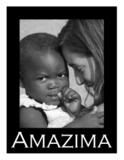This post will begin on a bit of a personal note and end on a resource note. I don't really like to post much personal as it could feel sort of intrusive to my boys as they grow up and become aware of what mom is doing on the blog.... but, I feel that this is going to be helpful for others, so I make an exception.
Most of our kids are undersized when we pick them up. Most catch up and stabilize. Some are older or have health issues that prevent them from really catching up. Malnourishment can indeed prevent a child from growing to potential. One of my son's has had steady and normal growth since we brought him home. He is right on track for his age in every way. One of my son's was so tiny and had a huge belly and stick arms and legs when we brought him home. He was almost 4. He could wear size 2 comfortably. That is not extreme by any measure. That is common. Yep, malnourished as a young child. What happened next is not so common. By the time he was actually 4 (four months after we brought him home) he was wearing a size 3. Pretty good growth. A year later, at age 5 he was in size 5. He gained more than 10 pounds and about 8 inches in height in a year and 4 months. He had caught up. Problem was that big belly was still there. Not as hollow as it once was but still there. Shouldn't it have gone away? We looked into all sorts of things. Many ideas came across our radar and we looked at each one. Nothing really panned out.
The following year he continued his growth pattern. By age 6 he had gained over 10 pounds more and only a few inches in height. He is now stocky, husky, a little overweight. We pulled back and again looked at what we are feeding him. Looked at his energy and activity levels. All normal. We adjusted his food intake to be sure he is getting the right things in the right amounts for his age, without him feeling deprived (big issue for him). He continued to gain weight. This kid never horded food but his body seems to be doing it for him., he never ate until he puked either. No, none of that. Yes, he wants to eat everything he sees, but we don't really make that an option. No matter how balanced his meals, how carefully we monitor his snacks and the amount of exercise he gets, he gains weight. Right now he is just at the high end. But coming from his situation and the fact that he was not even on the chart at first, in just under 3 years this is somewhat astonishing weight gain and could lead to issues as he grows up if we do not understand it now. Dieting is a bad idea for a child who comes from an impoverished situation. Panic. Fear. Mistrust. You know that sounds bad for attachment, even three years into it.
So, I look some more, I ask around some more. I am given a very interesting and eye opening article. WOW! This is the answer to why. I am so relieved to know the source of the issue for my son. Turns out that there has been some research done on this. The research is showing that persons who were born of a malnourished mother become overweight and even obese when they are able to consume a normal level of calories in a healthy diet. In probing this a bit more it seems that there is some indication that this is because the child in-utero did not receive enough nutrients and so their system did not develop the ability to metabolize the caloric intake of a healthy diet. Instead it developed in such a way that it is only able to handle the caloric intake of a person in a state of malnourishment. In this way the child survives and lives and grows and does not need as much to live. No one is saying this is healthy, however, a child born in this state is much more likely to live than a child without this situation who faces malnourishment. Therefore it serves the purpose of survival. Very interesting. So, due to international adoption and immigration, persons who having this "condition" as it were, come to America or Europe and go from super skinny to .... well, I guess what they are staying is to... overweight. And that is exactly what has happened with my son. He was 28 lb when we picked him up and at almost 3 years home he is now 60 lbs. That in contrast to our son (who is younger) who has had normal weight gain who was 30 lb. and is now 46 lb. The boys are of different tribal backgrounds and we attributed much of this to that, but maybe have been mistaken in doing so. They are only 8 months different in age.
What do we do about it? Well, that remains to be seen. In visiting with a new and adoption savvy as well as international issues savvy Dr. in our pediatric office, he confirmed all this and said he feels that is a reasonable explanation to my son's interesting growth pattern. He also noted that they are seeing more and more of this in internationally adopted kids. Presumably because there are more of them. Our son will be going for blood tests to see if anything that can be helped is out of whack. Thyroid, etc. Not expecting much. So, the dilemma, how to get a child who LOVES his food (and he gets good for you food and still loves it) to eat significantly fewer calories than his age recommendation.
Why? Well, just as in-utero his body did not develop the metabolism to handle a normal intake of food, his body, if left unchecked in an overweight status by age 7, will have more fat cells to store fat and therefore it will be harder to loose the weight after puberty.
In a picture: babies are born with a "normal" level of fat cells. If they are overweight at around age 7, as well as by the onset of puberty (around 10), then they have multiplied their number of fat cells and they can not be decreased. They will have to shrink them and that is harder if there are more than the right number. This is the issue with juvenile obesity.
For a child who was born with not enough fat cells, they gain a few, up to the normal level and are then overweight. The issue for a child born from a malnourished mother is that he has too few and gaining the right amount puts them at jeopardy of becoming an obese adult as their metabolic system is already out of balance genetically. Quite the conundrum really.
Want to read the article for yourself? Check it out in
The Economist.
Our sons are the two in the middle. The one in stripes with blue sleeves is 2 years 10 months old. He is a normal size for his age and has had normal growth. Our son in the pink is smaller and older, he is at this photo, 3 years and 6 months old. The clothing he was wearing a month later when we picked him up were size 18 months.
These are our boys at Easter 2011. You can see their growth. N (brown pattern tie) has had normal growth and is now 5 years 8 months. K (orange stripe tie) has had more growth than we ever expected. He is now 6 years and 4 months old. They are so very handsome!!!!





















































